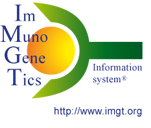DNA
DNA strands
The DNA is formed of two strands, constituted of deoxyribonucleotides.
The backbone of each strand comprises an alternative succession of deoxyribose (sugar) and phosphate, two successive deoxyribose being linked by their 3' and 5' OH, respectively, to a phosphate. The 1'OH of each deoxyribose is linked to a purine (adenine, guanine) or pyrimidine (cytosine, thymine) base. A DNA strand is read by convention from 5' to 3', that is from the 5'OH of a deoxyribose to the 3'OH of another deoxyribose.
DNA base-pair substitutions
A base-pair substitution in DNA results in a mutation. There are two types de base-pair substitutions:
Transition
- One purine is substituted by the other:
- Adenine → Guanine
- Guanine → Adenine
- One pyrimidine is substituted by the other:
- Cytosine → Thymine
- Thymine → Cytosine
In transitions (A>G, G>A, C>T, T>C), one purine is substituted by the other or one pyrimidine by the other, and so the purine-pyrimidine axis is preserved, that is the orientation of the purine and pyrimidine bases on each DNA strand remain the same: AT to GC, GC to AT, CG to TA, TA to CG).
Transversion
A purine is substituted by a pyrimidine or vice versa.
In transversions (A>C, C>A, A>T, T>A, G>C, C>G, G>T, T>G), a purine is substituted by a pyrimidine or vice versa, and the purine-pyrimidine axis is reversed, that is the purine-pyrimidine orientation on each DNA strand is reversed: ie, AT to CG, CG to AT, AT to TA ...).
The transition and transversion terms were coined by E. Freese 1959, Brookhaven Symp Biol. 1959, 12:63-75.
